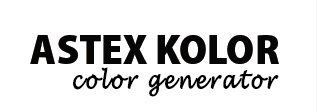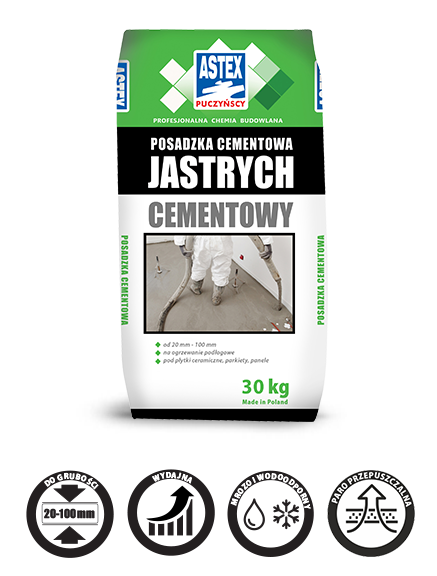Self-smoothing screed primer
Cement screed is used to make cement floors and screeds.
- ayer thickness from 20 to 100 mm
- For floor heating
- For substrate ceramic tiles, parquet and panels
- High durability
- Frost resistant
Calculate expenditure
Expenditure
20 kg / m² at a thickness of 10 mm
Shell life
12 months from the date of production
Packaging
30 kg
Application
Cement screed is an easy-to-use, factory-prepared dry mix, designed for manual or machine flooring and floor underlays, as well as terraces, balconies inside and outside buildings. It is used in small and large-scale construction, such as: residential and utility rooms, warehouses, halls, garages, basements, halls, offices, corridors, etc. After application, we obtain an even base for ceramic and stone tiles, panel floors, parquet floors and self-leveling masses, etc. Cement screed can be used for underfloor heating. This mortar is particularly suitable in places requiring high strength parameters for loads. Cement screed is intended for renovation of existing floors, as an intermediate layer, as well as for newly created substrates and in rooms with high humidity. Suitable for laying on moisture proof, acoustic, thermal and vapor barrier layers.
Properties
Cement screed is a ready, dry mix of the highest quality, based on gray cement class 52.5 R, cleaned sand, aggregates and modifying additives. It has very good properties in terms of workability, plasticity and adhesion to the substrate, which makes it a product with a very versatile application and easy to process. When mixed with water, it forms a homogeneous mass that is easy to spread. Screed is a frost and waterproof product. It is also characterized by very good tightness. It also affects the faster pace of construction works compared to traditional mortars made on construction sites. After binding, it is resistant to weather conditions. It is characterized by high compressive strength.
Substrate preparation
The substrate should be dry, matured, stable, even and sound, i.e. strong enough, cleaned of layers that can weaken mortar adhesion (dust, dirt, lime, oils, fats, wax, residual oil and emulsion paint, etc.). If necessary, mill and wash the surface. In the case of excessively absorbent substrates, moisten them with water or use UNI¬ASTEX primer, however, it is unacceptable to leave excessive amounts of the primer on the substrate. Repeat the procedure for a substrate with increased water absorption. If it is necessary to make a layer on solid substrates with a load capacity difficult to determine (e.g. dusty, difficult to clean), it is recommended to carry out an adhesion test consisting of applying a control layer and checking the connection after a minimum of 48 hours. Loose items must be removed. It is absolutely necessary to use circumferential dilatation (in the form of sealing tapes or polystyrene from 5 to 10 mm), threshold and around the load-bearing elements of the structure (pillars, chimneys, etc.). All structural expansion joints should be transferred to a self-leveling layer. Above 50 m², use expansion joints. Seal the poured surfaces.
Mortar preparation
Preparation involves pouring dry mortar (30 kg bag) into the container with the appropriate amount of water (4.5 L). Then mix the mass mechanically using a slow-speed drill with agitator (agitators) or a special aggregate (mixing and pumping) until a homogeneous mass is obtained. If necessary - add a small amount of water experimentally and mix again. The mass prepared in this way should be used within 40 minutes. It is unacceptable to modify the mortar by adding other components of construction chemicals, e.g. sand, cement, as this may cause loss of mortar properties.
Application method
Cement screed is applied manually to previously prepared substrate. Strip the freshly poured layer with a patch so that a smooth surface is formed. The poured out field must be vented with the aid of venting rollers. In the case of using leveling auxiliary materials (pipes, guides), remove them immediately and fill up and smooth out any defects. During the drying of the completed substrate, as well as during ripening, it is absolutely necessary to ensure good ventilation and ventilation of the rooms. When working outside, protect the applied layer from direct sunlight (drying out too quickly, which may lead to cracking of the layer), as well as protect the surface from direct rain. The air and substrate temperature during works as well as in the process of binding and drying must be positive (above + 5ºC). The work should be carried out constantly until the ground is completely covered. In addition to the recommendations provided, work should be carried out in accordance with building practice and health and safety rules. The manufacturer guarantees the quality of the product, but has no effect on the conditions and the way it is used. If in doubt, carry out adhesion tests. Fresh dirt should be washed off with clean water, and hardened dirt removed mechanically.
Technology
Depending on the construction of the ground: - ASSEMBLY SCREEN WITH SUBSTRATE, the thickness of the applied layer must be at least 20-35 mm. This is a direct application of a layer on an existing substrate without additional insulation (thermal, acoustic, moisture proof). Particular attention should be paid to the preparation of the substrate, thanks to which we will obtain maximum graftiness and the optimal effect of combining the mortar with the existing substrate. - Screed on a separating layer. The thickness of the applied layer must be at least 35-45 mm. It is performed on very weak and absorbent substrates, as well as in places where adhesion is difficult to determine. The most common separating layer is an insulation film or similar material that meets the insulation requirements. Remember to place the insulation material on a previously cleaned and stable surface. We put the insulation above the height of the expected undercoat. In the case of substrates exposed to excessive moisture, damp insulation is used, e.g. liquid foil using sealing tapes. - FLOATING SCREWS The thickness of the applied layer must be at least 40-45 mm. It is performed when using thermal and acoustic insulation. The most common separating layer is floor foam, hardened wool or similar material that meets the insulation requirements. This material is laid with staggered joints. In the case of substrates exposed to excessive moisture, damp insulation is used, e.g. insulation foil or liquid foil with the use of sealing tapes before laying thermal or sound insulation. - Screeds in combination with underfloor heating. The thickness of the applied layer must be at least 45-50 mm. It is made when underfloor heating (water or electric) is used in conjunction with the thermal insulation material. In this case, underfloor heating elements (pipes, hoses, electric mats) should be firmly and firmly attached to prevent displacement during the pouring of the undercoat layer. In the case of substrates exposed to excessive moisture, damp insulation is used, e.g. insulation foil or liquid foil with the use of sealing tapes before laying thermal insulation and a floor heating set. The minimum height of the sleeper over the top edge of the set construction should be 30 mm. Initial start of underfloor heating can take place after 7 days, and full after about 30 days
Expenditure
On average, 20 kg is used for 1 m² of floor with a layer thickness of 1 cm.
Packaging
30 kg paper bags. Pallet - 42 bags - 1260 kg overall.
Storage and transport
The mortar should be transported and stored in tightly sealed bags, in dry conditions (preferably on pallets). Protect from moisture. The storage period of the mortar in conditions consistent with the requirements stated on the packaging is up to 12 months from the date of manufacture placed on the packaging.
Temperature of performed work
Air temperature from +5 to + 25ºC. Substrate temperature from +5 to + 25ºC.
Precautions
Irritating product. Appropriate eye, respiratory and skin protection should be used. Keep away from children. Do not breathe dust. In case of contact with eyes, rinse immediately with plenty of water and seek medical advice. If swallowed, seek medical advice immediately and show the container or label.
Do you have questions? Doubts? Ask an advisor Contact form












